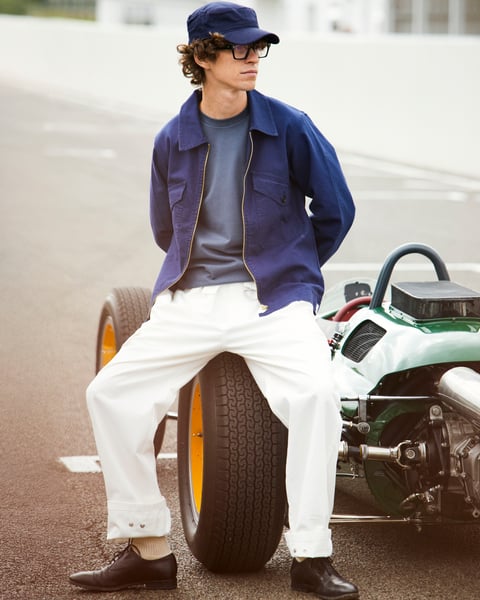The most significant moments in Porsche's history | Thank Frankel it's Friday
 Andrew Frankel
Andrew Frankel
This week Porsche released images of its ‘Vision 357’, a homage to the original 356 and an imagining of the kind of car Ferry Porsche might have envisaged were he starting his company today, rather than 75 years ago. And that’s the reason for the 357’s existence. In addition to the 60th anniversary of the 911, Porsche itself reaches its three-quarter century this year. It’s come a long way in that time.

The first production 356s were hand built in a former sawmill in Gmund, Austria, 74 years later it delivered over 300,000 cars (the vast majority SUVs) and made over $5 billion in operating profit in the first nine months… But what have been the most significant moments in the history of the company, even if not all were seen as such at the time?
Here are just a few, starting in 1951 when the French Porsche importer August Veuillet and a mate called Edmond Mouche to decided to enter Le Mans in a 356.The Gmund-built 1100cc car had less than 50bhp and, despite tacked-on wheel shrouds to smooth the airflow over the car, a top speed of barely 100mph.
To cap it all, it was one of the wettest Le Mans on record. Undaunted, the two French buddies started the race and just kept going. And going. The Porsche behaved perfectly and, 24 hours later, gave them not only the class win but a new record for the shortest time spent in the pits for the duration of the race. From start to finish and inclusive of all stops, it averaged over 73mph and turned in a best lap of almost 87mph, showing not only how fast the circuit was then but how little the tiny Porsche needed to slow down for the corners.
It finished down in 20th place where few people would have noticed it. But in its speed, consistency, efficiency and reliability, it set a template that would inform almost half a century of Porsche's participation at Le Mans. In short, the company had started as it meant to go on.

Next, I guess it has to be the debut of the 901 back in 1963. The story of the development of the car is long and storied and it would have taken little indeed for it to have turned out very differently indeed, not least if the original flat-six engine with its pushrod operated valves planned for it had not canned in favour of the far more sophisticated and easily tuned overhead cam engine that engineering common sense saw prevail. That engine would have a lifetime of several decades, during which it would win every major sports car race in the world.
After that? I guess it has to be Le Mans 1970, Porsche’s first win thanks to the 917, a car still regarded by many as the greatest racer of them all. So we’ll move on a bit to 1977 and the Porsche 928. By then the 911 was already old the front-engined, water-cooled, V8 powered 928 appeared better in every obvious way. Except that’s not how customers saw it. Porsche absolutely intended the 928 to replace the 911, but far from killing it off, it seemed to inspire a second lease of life for the rear-engined old soldier, one it is still enjoying to this day.
I’m jumping ahead to the early 1990s when Porsche found itself in a genuinely existential crisis. By now all its products – the 911, 968 and 928 were ancient and so beautifully engineered, that Porsche was making a loss on every car it sold. Something had to be done, so Japanese consultants were hired who told Porsche a few home truths, resulting in all product lines being canned and one platform off which the Boxster, an all-new 911 and, eventually, the Cayman could be spun.

We’re into the 21st century now and the car that turned Porsche from a niche manufacturer of low-volume sports cars to a serious player on the global stage. Few of us liked the idea at the time, but no one could deny the transformative effect the 2002 Cayenne had on Porsche's business. Twenty years later in 2022, Porsche sold over 95,000 Cayennes, making it its best-selling product.
The transformation had been overseen by Wendelin Wiedeking who might have been remembered as the best boss Porsche ever had if he’d not mounted a hostile takeover bid for Volkswagen in 2008. It was like a mouse trying to swallow an elephant and it soon blew up in his face. He lost his job (though was left crying all the way to the bank with a massive severance package) while VW snapped up Porsche, the precise opposite of what had been intended.
That brings us almost to the present day when, in September 2022 Porsche launched an IPO on the Frankfurt Stock Exchange that valued Porsche at €78 billion, the largest European IPO by market capitalisation in history.
What’s next for Porsche? It continues to race sports cars, in Formula E while rumours of a Formula 1 entry of some kind refuse to go away. Whatever the future holds, it is unlikely to be boring.
917 image courtesy of Motorsport Images
Porsche
Cayenne
917
911
Vision 357
928





